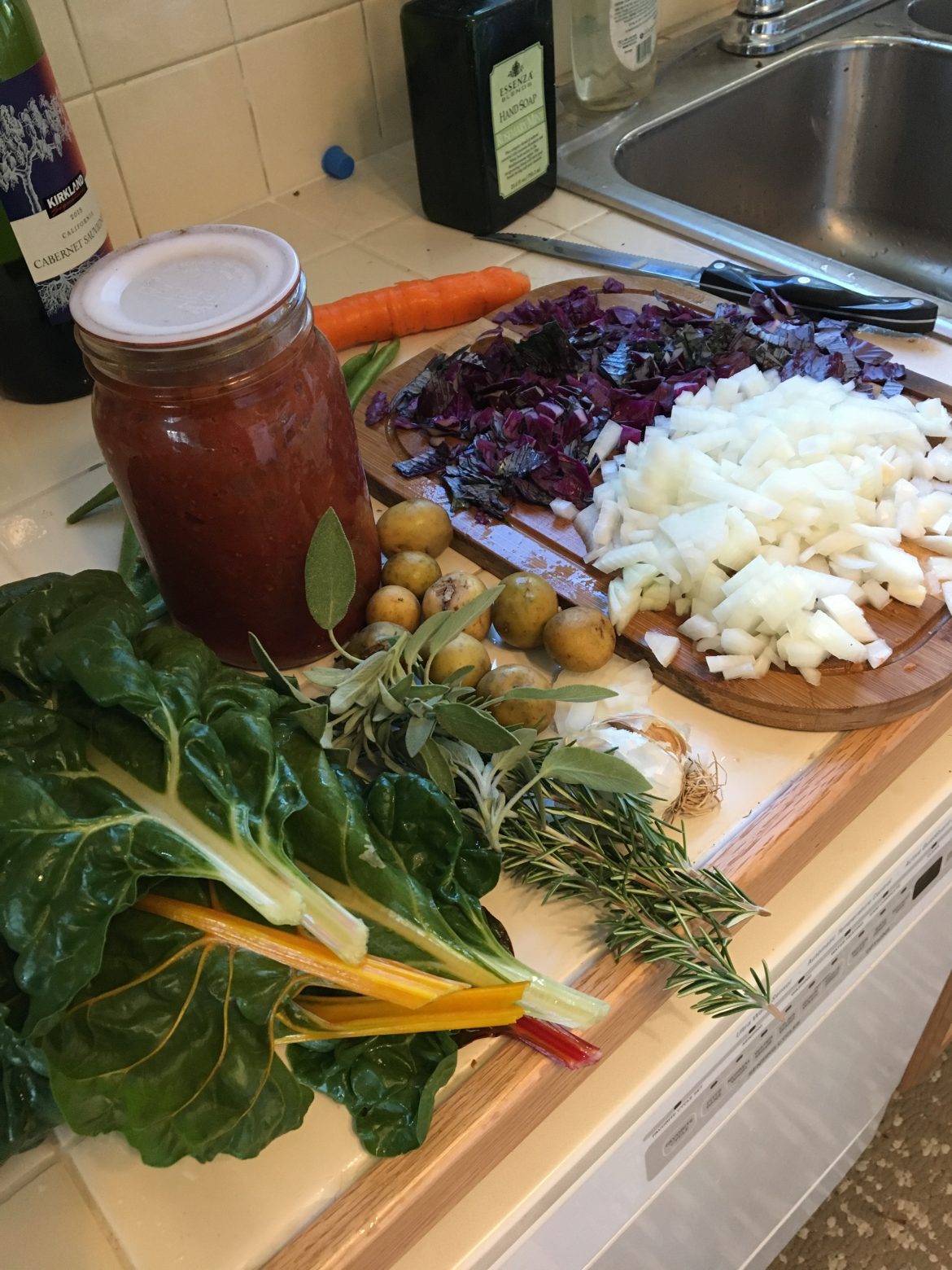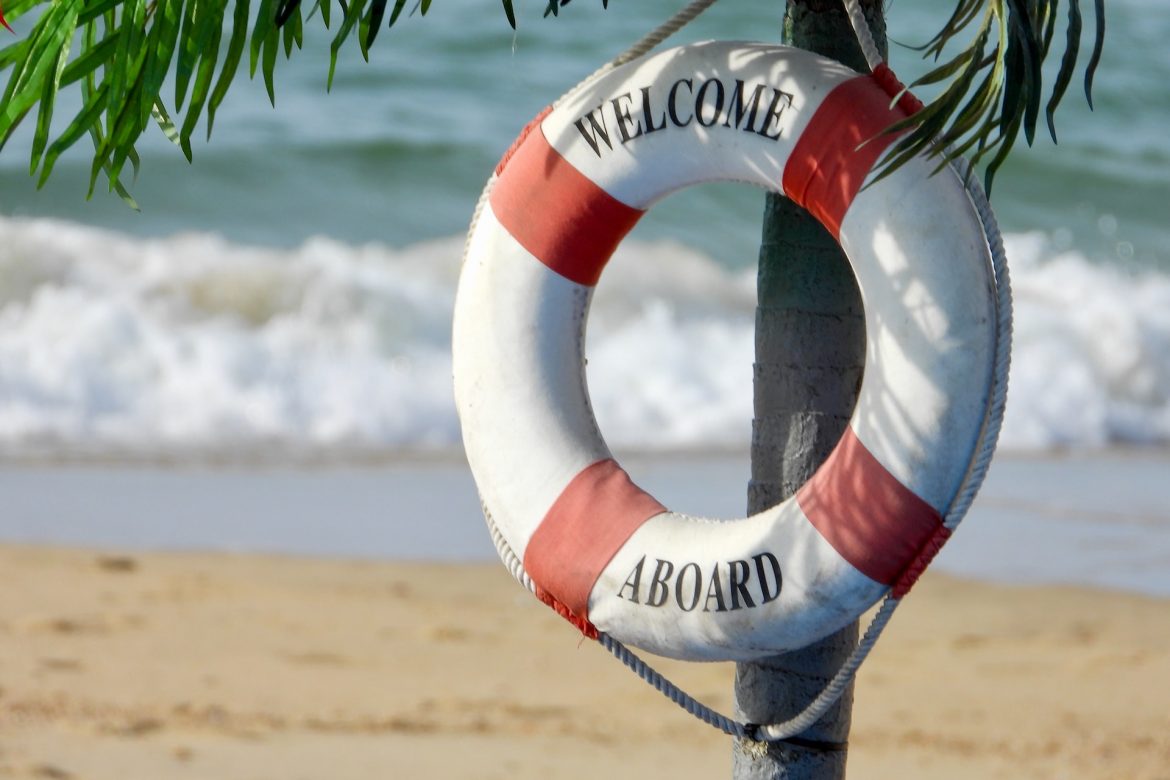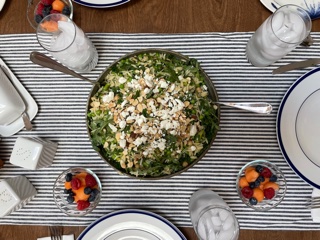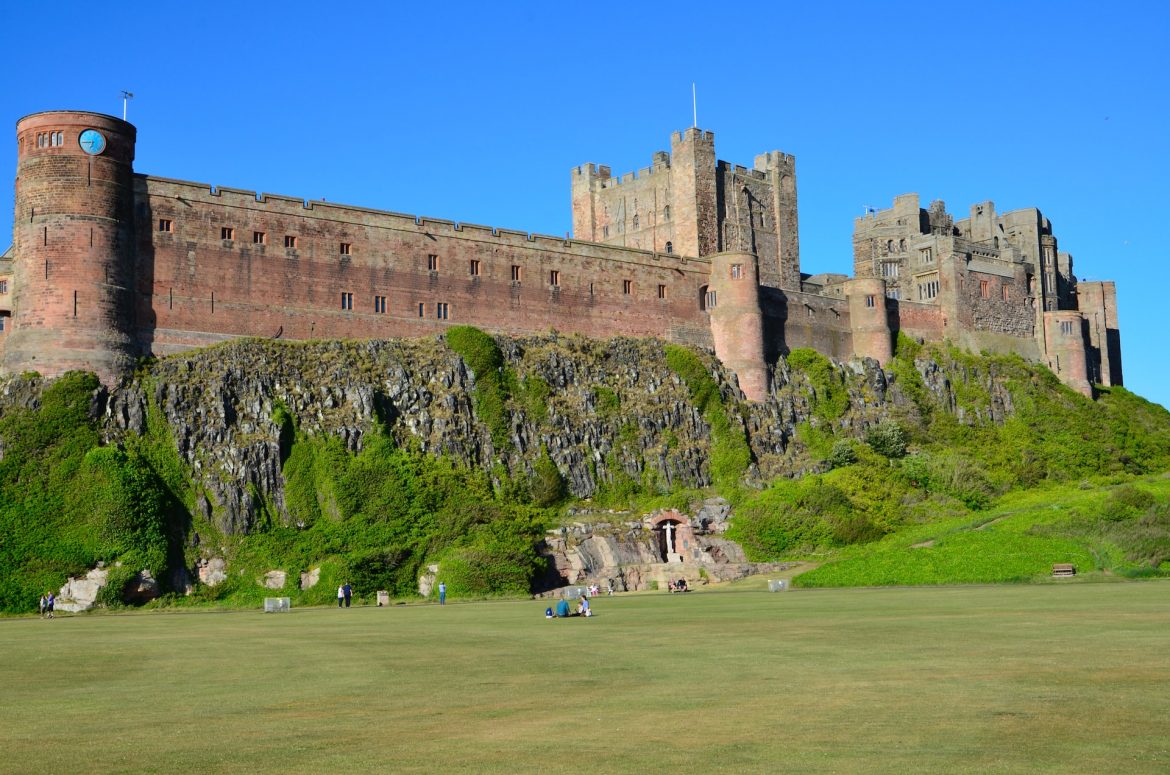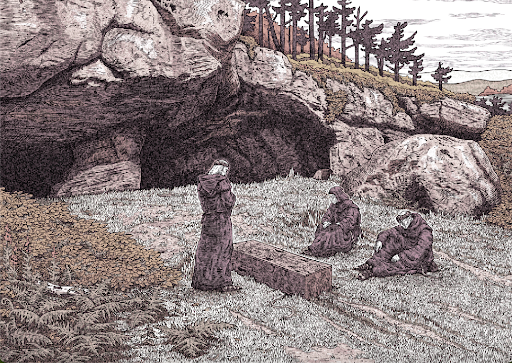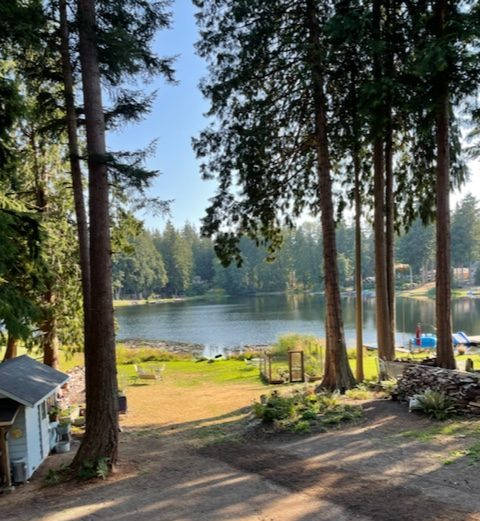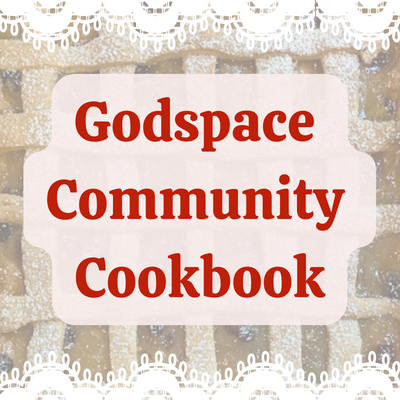Editor’s Note: The following reflection has been excerpted from Hospitality – Open Doorways To The Kingdom With Us. The accompanying recipe is from Hunza Pie – Great Way To Use Greens. We hope you enjoy this series of seasonal hospitality reflections and recipes!
Don’t forget to show hospitality to strangers, for some who have done this have entertained angels without realizing it! (Hebrews 13:2 NIV)
These words revolve in my mind today as I remember rich hospitality we have experienced in the last couple of months and anticipate the hospitality to come. Easter is over and we have entered a season that beckons us to be hospitable to friend and stranger alike. One of Christ’s first appearances after his resurrection is as the stranger on the Emmaus road, His true nature is recognized only when he breaks bread together with his fellow travellers. This is the first Eucharistic celebration of the new kingdom. He also comes as Christ, the friend by the sea of Galilee, preparing breakfast for his closest followers.
Through the doorways of hospitality to friend and stranger, those first disciples were welcomed to the banquet feast of God. Today too, the purpose of God’s people is to invite stranger in and offer hospitality by breaking bread together, sharing the Eucharistic feast. By so doing we both welcome Christ and represent Christ.
~ ~ ~
Hunza Pie
A great vegetarian dish for a picnic or camping trip. the vegetable mix can be adapted depending on what vegetables you have available and what you like.
INGREDIENTS:
– 2 cups whole wheat flour
– 1 cup wheatgerm
1 cup golden flax meal
– 6 ounces margarine or butter
– 1/2 cup milk or water (I sometimes use whey left over from making yoghurt)
– 1 teaspoon vegetable salt
– 25 stalks Swiss Chard or other garden greens ,leaves coarsely chopped
– 2 1/2 lb potatoes
– 1 1/4 lb cottage cheese
– 1 teaspoon mixed herbs (I like Italian herb mix)
– 1 teaspoon salt
– 1 large onion, chopped
– 1 teaspoon dried basil, or 1/4 cup fresh chopped
– 2 cloves garlic, minced
– 1 cup mushrooms, diced
– 1 cup squash (e.g. zucchini), chopped or 1 cup broccoli
METHOD:
1. Pastry:
2. Sift flour and salt into bowl. add husks in sifter to flour fold in wheatgerm and flax meal. Rub in margarine until mixture resembles coarse breadcrumbs. Mix with enough water to make a stiff dough. Knead lightly. Cut pastry into 4 pieces. Cover and place in refrigerator for 20 minutes. Roll out 1/4 of pastry on floured surface and place in base and up sides of a 9 inch pie dish. Do same with second pastry section. Spoon over cold vegetable mixture. Brush edge of pastry with water. Roll out remaining pastry in 2 pieces and place over pies. Trim edge with a sharp knife. Make slits in top. Bake in a hot oven (400) for 15 minutes then reduce heat to 375 and cook further 15 – 20 minutes until golden brown.
3. Filling:
4. Peel potatoes and cut into cubes. Cook in salted water until tender. Drain.
5. Cook onions in a medium skillet with 1 tablespoon oil until brown. Add chopped mushrooms and squash. Cook a further 5 minutes. Add chard, garlic and herbs. Cook a further 5 minutes. Add cottage cheese and salt. Allow to cool.
SERVINGS: 12 from each pie
We love to eat it with hot sauce together with a tomato, basil, squash and mozzarella salad or with a quinoa salad.
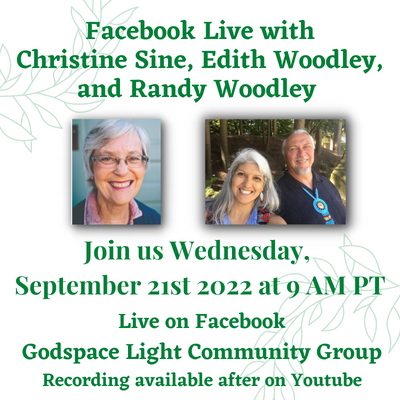 Next Facebook Live!
Next Facebook Live!
Join Christine Sine, Randy Woodley, and Edith Woodley for a discussion on Hospitality and the Land. Wednesday, September 21st at 9 am PT. Happening live in the Godspace Light Community Group on Facebook – but if you can’t catch the live discussion, you can catch up later on YouTube!

Tom and Christine Sine are looking for a new on-site assistant. This job is based in Seattle; while some work can be done remotely, our most pertinent needs and vision for the assistant requires on-site interaction. In addition to financial compensation, we pride ourselves on hospitality while our assistant is on-site – including sit-down lunch, garden goods, coffee, tea, and treats as we have them. Not to mention sharing the sweetest coworker – our dog Goldie. Compensation is $25/hr.
Based on the variable requirements, we are looking for someone who is able to do 20-25/hrs per week. This job is quite flexible; some weeks will have more to do and others less. Good communication is key, and we do ask for some consistency in hours week to week. The job is quite varied and includes editing and posting for the Godspace blog, updating resource pages, producing weekly emails through Mailchimp, basic bookkeeping and the opportunity to hone your own creative skills by writing and working on design and editing for new products – and more, but this is the basic overview of what we are looking for.
While having experience working with the following is a plus, it is not necessary: Wordpress, Mailchimp, social media, office suite/apple suite, iMovie or other video editing software, Canva or other graphic editors, amazon kindle editor, financial software such as Quicken or Banktivity, and more. Each program we use is simple and quick to learn and only requires minimal skills. We will teach you!
We look forward to hearing from you! Email godspacelight@gmail.com to apply
Feature Photo by Nick Fewings on Unsplash
by Jamie Noyd, via Lilly Lewin
Editor’s Note: Lilly is on vacation this week, and her friend Jamie Noyd generously contributed this reflection for her Freerange Friday! Jamie Noyd lives in Northern Kentucky and serves with InterVarsity Christian Fellowship on the national Faculty Ministry team as an Associate Director and Director of Via Divina for Faculty developing and directing pilgrimage experiences.

When I consider living into the practice of hospitality, I think of creating lovely, tidy spaces. Whether it was my dorm room in college or bedroom at home, I have always enjoyed selecting items that would tell my story even as the space welcomed friends to gather. I have since transferred this energy to a small home that I’ve redecorated over the past decade. Each space is comfortable, coordinated, and connects to passions for literature, pilgrimage, and beauty.
One thing these spaces aren’t – they aren’t messy. The order provides a sense of peace into which I can invite others, but maybe this tidiness also includes a bit of control that inhibits fully welcoming them. When I first set up my home, I pictured many groups of friends and family gathering here. Hanging out. Having deep conversations. Feasting over meals cooked together. But that didn’t happen for years.
At some level I wanted to manage the relationships as I managed the home, just as I had seen my parents do. During my growing up years, my family presented safe, neat images of our lives whether at home, at church, or with friends. That is, stories with little conflict and little mess. Though the messes existed, I learned early on that it was best to cover them up with a pleasant exterior. When people came over to visit, life and spaces needed to be in order. Not having experienced many other types of hospitality, I followed the family way.
I thought such tidy stories and places would welcome people and they did to an extent. However, the type of community I longed for didn’t develop. At first I wondered if I hadn’t shaped the places and the image of myself just right. I had assumed that if I, like my parents, kept out the messiness, then people would want to come. So I tried harder to create the right space and the right story. But, it seems, that the lack of deep connections wasn’t because I didn’t shape the space or times well, but because I tried to shape them too much. The tidy images of how I wanted a dinner to go or a conversation to progress often superseded what was actually happening. In this mindset I missed connecting with people in what was taking place right before me. I missed community.
Over the past couple of years I’ve been learning that nourishing, soul-filled hospitality that brings about deepening relationships isn’t about shaping a flawless space or conversation. It’s about showing up messy and allowing unfinished stories to bump into one another. But before I could invite others along this new path, I first had to show up messy with myself. I had to tear apart the boxes that held those safe, neat images.
One of those boxes is that of scholar. For decades I strove to be thought of as a scholar in a tweed jacket, professorial sort of way. However, I’m more of an unconventional learner, passionate about pilgrimage and literature, but not drawn to the rigors of the academy. I wondered if people would listen to what I had to share if I veered from that traditional path. Another box is that of single woman. It seemed that people were (or maybe I was) most comfortable with my being either a contented and strong woman not desiring male companionship or someone in a committed relationship. However I don’t want to sit in the first box anymore, nor can I make the second happen. As I started questioning the images of the scholar and the single woman in which I had packaged myself, I felt lost.
These are scary places. They hold both tears and laughter. There’s a lot of fear. And quite a lot of hope, in an uncertain sort of way. I was scared about sharing these messy stories with others. Scared that people would turn away when I left the boxes.
But . . .
They have stayed. And they have even stayed longer than I had expected in this messy way of being. This shouldn’t have been so surprising. In the gospels, the people who open up fully in all their mess to Jesus are the ones who fall deeper into community with him. I think of the Samaritan woman at the well and see Jesus’ hospitality as he sits with her in the questions and discomfort of her situation. In this space of welcome, she draws closer to Jesus and eventually to the rest of the village. I also think of Peter walking with Jesus after the resurrection. Jesus steps into the mess of Peter’s denial by asking three times if Peter loves him. As Peter stays with this conversation in its pain there comes an even deeper relationship with Jesus. This pattern is repeated over and over. Those who open up their messy lives find a community — those who stay in their boxes, end up walking away.
Now I see hospitality not primarily about creating those tidy spaces. It’s about sharing and walking with one another in our messes. I still have those well-ordered gathering areas in my home. Not sure if that will change. But in those spaces I’m not neat. The items I love are all around: travel photos, teapots, books, desks, pottery. However, they no longer represent finished stories in my life. Now, they are ways to open up renewed stories in all the pain, joy, and mess of life. As I gather with others laying out desires and passions, fears and griefs, I’m seeing God show up and shaping surprising stories. It’s a rich hospitality of messy community.
What are your stories of hospitality that welcome messy community?
 Did you know that alongside Christine Sine’s book The Gift of Wonder, we have many resources available to you? The free downloadable bonus packet or beautiful prayer cards featuring prayers from the book, for example – something to hold and behold! Or perhaps you’d like to journey through the book alongside a retreat – we have that too! You can check it all out in our shop!
Did you know that alongside Christine Sine’s book The Gift of Wonder, we have many resources available to you? The free downloadable bonus packet or beautiful prayer cards featuring prayers from the book, for example – something to hold and behold! Or perhaps you’d like to journey through the book alongside a retreat – we have that too! You can check it all out in our shop!
by Emily Huff
“There is a crack in everything. That’s how the light gets in.”
-Leonard Cohen
Tomorrow marks the 10-year anniversary of when our moving truck arrived to our home with our stuff when we moved to Seattle, and the story of how we landed here in our neighborhood speaks volumes of what I have learned about hospitality through the years.
From AOL mail
Sun, Sep 9, 2012
Subject: the story of our stuff
It has taken me a while to gear up tonight to write about what happened today. Suffice it to say that our move was a nightmare. A lot of the boxed items made it fine (as I packed all of those in June and July myself), but unfortunately, the bigger sentimental items that were under the care of the moving company (dining room table, the wardrobe that my dad refinished for us, parts of the bed he made for us, and my grandmother’s desk to name a few) were not even wrapped up and were just thrown in the truck. They have lots of scratches and breaks. At a certain point, we stopped reacting in shock and just kept taking pictures of damage so that we can file claims. The kicker is that many of these items aren’t simple “Ikea replacements.” And yet, our neighbors were incredible (over 10 people showed up to help us move stuff in). And let me remind you that we only moved here on August 25th, and we already feel such a deep sense authentic community here. And at the end of the day, we are hoping that the scratches and eventual repair scars and marks will always serve as reminders to us of people’s (and God’s) grace and hospitality today and a challenge to remember that this is after all just “stuff.”
As we said in Kenya a lot, “God is good all the time. All the time, God is good.” I also was thinking about the hymn today; “It is well with my soul”– this was written by a man who had just lost his 4 daughters in a shipwreck in a storm. Goodness, we did not lose people today. It was just stuff. It truly is ALL about perspective.
I walked down to church tonight and was not surprised that the sermon seemed to be written just for me. It was all about when Jesus turned water into wine and our pastor pointed out that this story points to the bigger truth that when we face problems, we have a choice to either focus on the problem or to look to Christ. With the gift of community today, I am so thankful that we have been able lean into this truth more.
When I talked to my daughter about it tonight and asked her how she was doing and feeling, she put it best: “I’m mad, sad, disappointed, and frustrated, but I am so happy about our neighborhood.”
As I look back at this, I am struck by how beautifully grace showed up on that particular day through our neighbors. One neighbor showed up that morning in our empty house and offered to pray with me before the day began, and she got snacks and drinks that day to keep people’s spirits up. Her husband made numerous calls to reach out and rally the neighborhood to pitch in when we realized that it was going to be a long day, and we had our first glimpse that he’s a mover and a shaker and the best advocate a neighbor could ask for. Four guys in the neighborhood were among the first of the burly men to show up and recruit even more muscles to chip in with hauling boxes and furniture. The college guys renting rooms in one of their houses whom we had never met before that day created a human chain to carry boxes into the house and were worth their weight in gold. Another family invited us over to their house that night for an unforgettable steak dinner and welcomed us around their table. We experienced John 1:14 in living color that day: “The word became flesh and blood and moved into the neighborhood. We saw the glory with our own eyes, the one of a kind glory- like Father, like Son– GENEROUS INSIDE AND OUT— true from start to finish.”
I was in a fragile place that day- exhausted from the move itself and emotionally raw from leaving beloved grandparents and dear friends behind. And I was just plain done from the terrible, horrible, no good, very bad day that we had had, but the way our new neighbors showed up felt like a scene out of Les Mis when Jean Val Jean is given the silver candlesticks from the priest. We did not deserve this grace, but we were experiencing God’s lavish gifts through our neighbors, and it was all I could do to not dissolve into a puddle of tears with gratitude.
A friend of ours who was a professor of English and cinema studies sent us this response after we relayed what had happened. “What a story! It’s a cautionary tale about choosing moving companies, but it’s also an IT’S A WONDERFUL LIFE ending, isn’t it? Potter may still have the $8,000, but he’s alone on Christmas Eve. So thankful for all those near and far who have helped to make this side of the story WONDERFUL!”
Another friend emailed me that following week these words that I now have displayed in our kitchen symbolically in one of the frames that was broken in our move: “In the coming days, as you discover and rediscover the brokenness of life, may you be reminded of His perfecting work. May your heart continually turn to Him to be repaired and healed, and may His glory shine through.”
I was pinching myself in those early days in the neighborhood recognizing that we had landed a community that gathers around broken pieces and works together to bring healing and restoration. While I felt fragile and was literally piecing our stuff back together, I resonated deeply with these words from Ted Loder: “What can I believe, except what Jesus taught: that only what is first broken, like bread, can be shared; that only what is broken, is open to your entry; that old wineskins must be ripped open and replaced if the wine of new life is to expand.”
We experienced hospitality in a way I had not seen it lived out in a neighborhood quite like this before. I remember an article in a Young Life magazine years ago talking about Young Life leaders being “Jesus with skin on,” and I can say without a shadow of a doubt that we encountered the living Christ that day as we were welcomed so beautifully.
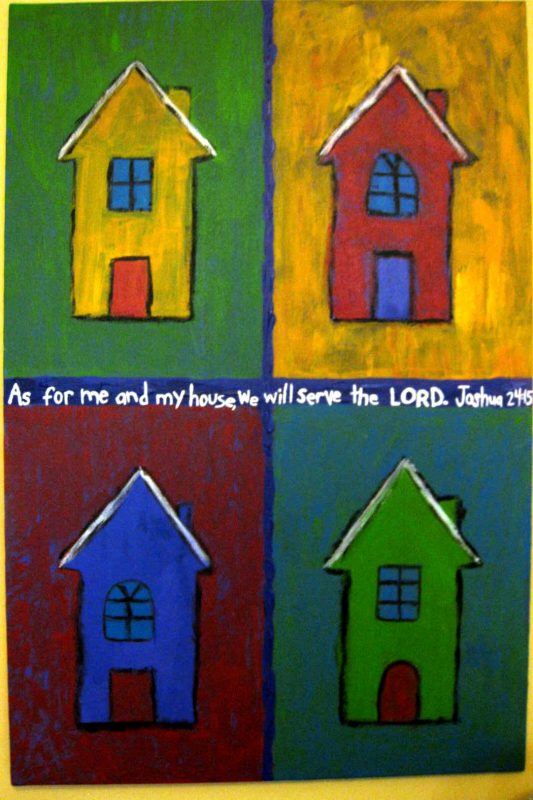
One year my neighbor Annie sent out holiday cards that said, “Loved people love people.” As we experienced such grace and hospitality, we then could settle in and begin to welcome others into the community who came after us. “Now that I’ve put you there on a hilltop, on a light stand – shine! Keep open house; be generous with your lives. By opening up to others, you’ll prompt people to open up with God, this generous Father in heaven.” Matthew 5:16.
Heidi Haverkamp writes about Benedictine hospitality and I think it relates to our neighborhood as well:
“Receive every person who comes through your door as though they were bringing Jesus to you. Receive every person you meet as though you were encountering the face of Christ … Part of what makes a monastery a healthy place is to receive guests, so that the monks or sisters don’t get turned in on themselves, or imagine that they’re the center of the world, or that only they are good Christians. Part of what makes a church a healthy place is to receive guests, so that we don’t imagine we’re a club, or a secret place. A church should be a place anyone can come to meet Jesus, and a church is a place where anyone who comes can be a way for the other people there to meet Jesus. That’s why hospitality is so important. Because it helps us meet Jesus.”
I am grateful for the way I have met Jesus in profound ways here in our neighborhood over the last 10 years as He has shown us His love through our neighbors time and time again. And, I am grateful for these people with whom I share the journey that we get to keep pointing each other to the light in the broken stories we carry together.
Painting by Emily Huff
 Looking for hospitality inspiration? We have an entire resource page dedicated to hospitality. Find recipes and reflections on numerous hospitality topics, including Celtic hospitality, prayers, and liturgies. Click on Hospitality for more!
Looking for hospitality inspiration? We have an entire resource page dedicated to hospitality. Find recipes and reflections on numerous hospitality topics, including Celtic hospitality, prayers, and liturgies. Click on Hospitality for more!
‘In God alone there is rest for my soul,
From him comes my safety:
With him alone for my rock, my safety,
My fortress, I can never fail.’
A month ago, (before inflation might I add), my husband and I purchased an annual ‘Historic Houses’ membership which enabled us to view many beautiful castles and stately historic homes where we live in the North-East of England, and also where we holiday on the borders of Scotland, but also further afield … whenever we wish.
After one month, we’ve more than paid off our membership, with eleven months still to go of free visits! It’s been a super deal; and so far we’ve already visited five beautiful places in such a short time – Chillingham Castle, Bamburgh Castle, Lindisfarne Castle, Abbotsford and Paxton House.
So it’s opened up a brand-new world for us.
Before this, we often felt that entry fees were rather too expensive for the actual length of time we might have to spare on a fleeting visit, so we would view the outside only, and continue our walk. But now, having seen the inside, as well as the outside, of so many of these wonderful landmarks in such a short time, it has given me a real insight into a psalm which I read this morning, Psalm 62, which speaks of God as our rock, our fortress and our refuge.
These impregnable fortresses built on solid rock; these sturdy castles built to guard and protect life; these stately mansions filled with marvellous treasures; using stone of the best quality from either local quarries, or pillaged from Roman walls or structures that have fallen into disrepair, seem built to last! They look solid, secure and are well-fortified.
So when beset by worries or anxious thoughts or the troubles of this world, or hemmed in by dark spiritual powers that besiege us, or in need of sustenance with souls that feel empty and dry, we can flee to God for protection and reassurance, safe in his arms. We can benefit from deep reserves of living water within the walls of his protection, by way of prayer and stillness. We can enrich our dry and weary souls anew, by being a blessing to those who are already enfolded in the very heart of God, the blind, the oppressed, the needy of our world, his real treasures.
In God, our hearts, souls and minds find peace and contentment.
In God, we are strengthened and renewed.
In God we are refreshed and fed.
In God alone!
My Soul Finds Its Rest by Sheila Hamil
Photo by Ben Cuthbertson on Unsplash
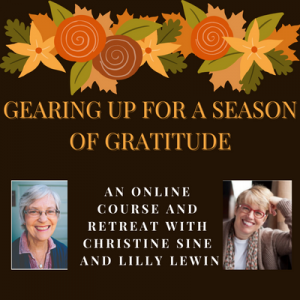 Christine Sine and Lilly Lewin inspire ways to get geared up for the coming season of gratitude in this popular online course! Sign up for 180 days to enjoy this retreat at your own pace – including craft tutorials and print-outs plus much more. Check it out in our shop!
Christine Sine and Lilly Lewin inspire ways to get geared up for the coming season of gratitude in this popular online course! Sign up for 180 days to enjoy this retreat at your own pace – including craft tutorials and print-outs plus much more. Check it out in our shop!
guest post by David Pott; all photos courtesy of David Pott. Featured photo: St Cuthbert’s coffin with monks by St Cuthbert’s Cave from the album cover of Take Up My Bones by Arð – Artist: Gabriel Danilchik
Here in the UK I am on the hunt for coffin carriers! It’s not just to walk from a hearse to a graveyard, but to assist with a challenging 130-mile pilgrimage actually carrying a coffin through northeast England from the River Tees via Durham, Newcastle and up the coast to Lindisfarne from September 12-24th. So how has all this come about?
Early in the year I became aware that the amazing illuminated Lindisfarne Gospels are coming back to home territory and will be on display at the Laing Art Gallery in Newcastle from September 17th until December 3rd 2022. I noted that already a range of activities and events were being planned, but nowhere was there any talk of pilgrimage! Why would a pilgrimage be appropriate? St Cuthbert who lived c634 – 687 was perhaps the greatest of the Northern Saints – a man of great holiness and compassion who was both a bishop and a hermit and known as a miracle worker. About a hundred years after his death, raids by Vikings led the monks on Lindisfarne to flee, taking with them in a specially made coffin, the body of St Cuthbert and the precious Lindisfarne Gospels. For 200 years the coffin travelled widely around the north of England keeping one step ahead of the Vikings, until in 995 they felt it was safe to return from Ripon to Lindisfarne. However Cuthbert, apparently communicating from his coffin, had other ideas which is why his shrine is at Durham Cathedral and why the city came to be. When you consider all those coffin journeys with the Lindisfarne Gospels back in the 7th to 10 centuries, surely a pilgrimage to celebrate the presence of the gospels in the region would be appropriate?
With mixed feelings, knowing what all this might involve, I felt that familiar stirring within and a call to propose a pilgrimage. As the vision clarified, I imagined taking a facsimile of the Lindisfarne Gospels in the coffin with us. There is an admission charge for the exhibition so limited numbers will see it, but taking a facsimile through the region would enable many more people and especially school children to see and handle it and learn its amazing story.
In March, I committed to pray daily that if this vision was on God’s heart, there would be confirmations during that month. That definitely came and included the offer of the £6,000 facsimile copy of the gospels belonging to the Religious Resources Centre for this area. It is hugely impressive and the biggest and heaviest (9kgms!) book I have seen. Also I was so encouraged when the Durham and Newcastle Dioceses agreed that the pilgrimage would be their main contribution in connection with the exhibition.
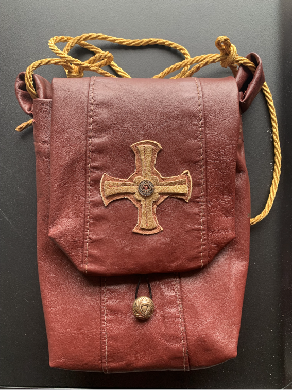
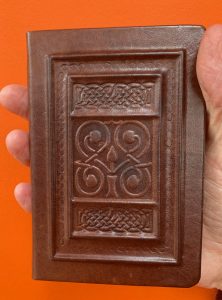
So on the strength of these positive indicators I ventured forth, but I have had my wobbles as I have faced the organisational mountain! One morning in May, when I was struggling with it all, the scriptures in Celtic Daily Prayer began with Psalm 84:5 “Blessed are those whose strength is in you, who have set their hearts on pilgrimage.” I knew that the pilgrimage preparation was beyond my own strength, but that it could be done through God’s power. I wrote in my journal that I needed to look upon this as a 4-month pilgrimage until it’s physically completed on September 24th. Moments later I was reading the next passage for that morning in John 4 which included “4 months until harvest!” I felt that was a very reassuring promise for me. There will be a harvest through this pilgrimage – I’ve no idea what that will look like, but a harvest there will be! A few days later the reading was Genesis 26:12 “Isaac sowed seed in the land and the same year reaped a hundredfold.” So as I write emails and make phone calls to people all along the route of the pilgrimage, I imagine it as sowing seeds for this harvest.
As I continue to work through the admin mountain, there are many encouragements such as the fact that around 30 schools are going to take part. A local undertaker has said he will supply us with shoulder pads, but best of all, my daughter Emily has made a most beautiful leather pouch. This will hold a facsimile of St Cuthbert’s Gospel of John which was his favourite gospel. This book, which is only 5.4 x 3.6 inches, is the oldest book in Europe which still preserves its original binding. We know that during the coffin journeys it was indeed carried round the neck in a pouch.
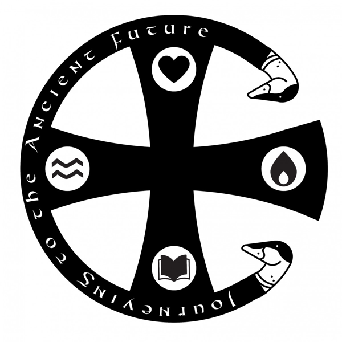
Another delight is the specially designed logo we will wear on our t-shirts. The letter C does not just stand for Cuthbert or for the coffin, but also for the cross which is central and also especially for Christ. Carrying the coffin is in some ways analogous to carrying the cross. The cruel cross symbolised Roman oppression and death and yet Jesus totally transformed its meaning by dying on it. In the same way, the coffin is perceived as very much associated with death and yet our coffin we trust will have a transformed meaning as it will contain the Word of Life. The symbols for love, life and light are key themes for us and very prominent in Cuthbert’s favourite gospel of John. The book symbolises the gospel as well as learning. The ducks are actually eider ducks which are often called cuddy ducks after St Cuthbert. They remind us of St Cuthbert’s great love for creation.
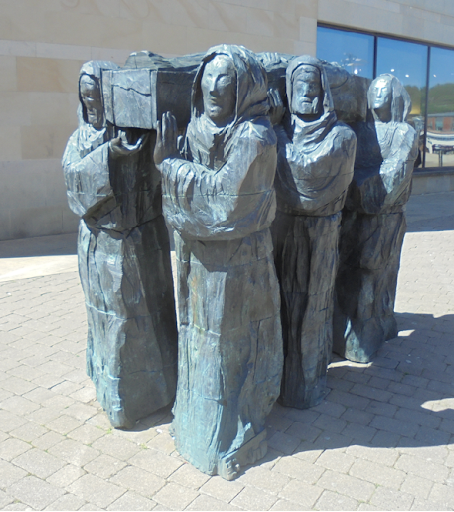
This statue by local sculptor Fenwick Lawson in Durham’s Millennium Place recalls the coffin journeys. There were seven coffin carriers at that time and there will be seven people taking care of the coffin and the facsimiles on this pilgrimage. We will certainly be glad to welcome others joining us to relieve weary shoulders and share the load!
Finally, in the late 10th century, Aldred, who was provost of the community in Chester-le-Street and who inserted his translation in early English into the Lindisfarne Gospels, added some valuable information at the end of the book. He mentions that Eadfrith, the Bishop of Lindisfarne “wrote this book for God and St Cuthbert.” In both the planning and the execution of this pilgrimage, we can do no better than adopt the same purpose. May all that is done “for God and St Cuthbert” be a rich source of encouragement, enlightenment and blessing for all who participate.
All the basic information about the pilgrimage is here: https://durhamdiocese.org/the-lindisfarne-gospels-pilgrimage/ It includes details about joining the pilgrimage which is happening September 12-24th.
If you would like a prayer diary to follow the pilgrimage, please email David at dlpott@gmail.com
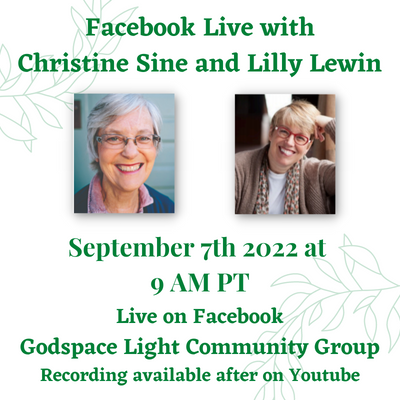 Join Christine Sine and Lilly Lewin LIVE on Wednesday, September 7th 9:00 am PT for a discussion on Celebrating the Gift of Life. Find the live discussion in our Facebook group, Godspace Light Community Group – or stay tuned to Christine Sine’s YouTube channel to catch it later!
Join Christine Sine and Lilly Lewin LIVE on Wednesday, September 7th 9:00 am PT for a discussion on Celebrating the Gift of Life. Find the live discussion in our Facebook group, Godspace Light Community Group – or stay tuned to Christine Sine’s YouTube channel to catch it later!
I have just returned from a couple of wonderful days at Lake Ketchum visiting a good friend. We went kayaking, created hypertufa pots and we observed morning and evening prayers each day from the Northumbria Community‘s wonderful book Celtic Daily Prayer. In the mornings I sat and drank in the beauty of Lake Ketchum and the delight of being so close to God’s creation. The dragonflies fascinated me and the deer feeding her young by the lake was an absolute joy. In between time we talked about life, spirituality and the tools we need to remain resilient and grounded in our faith. We also ate lots of good food, including this wonderful Norwegian bread recipe my friend often makes.
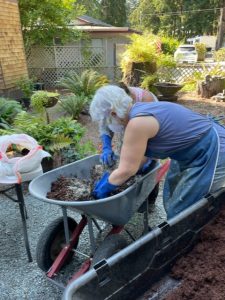
Mixing hypertufa mixture
The richness of this time of hospitality was refreshing and renewing, as good hospitality always is. And the hospitality was expressed in so many ways. There wasn’t just the hospitality my friend offered, there was also the hospitality of the beautiful place in which she lives and of the creatures that inhabit it. There was also hospitality expressed by her sister and friends who invited me into their friendship circle for a little while to make the tufa pots. And there was the generosity of another friend who came to visit while I was there.
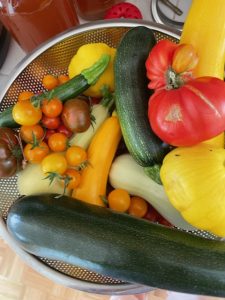
Our hospitable garden
When I returned home I embraced yet another form of hospitality, the hospitality of returning home. The warmth of my welcome by my husband Tom and our dog Goldie made me aware of how easily we take the hospitality of a good home and relationships for granted. The delight of walking round the garden to harvest beans, tomatoes, squash and basil added to my sense of welcome. The generosity and the bounty was a wonderful gift of hospitality from God whose gifts of good food we eat every day and often take for granted.
Being a good guest, as Diane Woodrow suggested last week, is to delight in being in a place. To delight in the experiences, the food and the friendships we are presented with. And as I discovered this week, being a good guest is just as important at home as it is in someone else’s home. We are all guests, not just of God but of our families, our friends and of our world. Accepting the bounty that is provided and thanking those who have tended it in our absence is as important as thanking those we visit and share fellowship with.
Watch this video of morning prayers from Northumbria. The Celtic saints who inspired these prayers were very hospitable people. Take time to contemplate their lives and the ways they reached out to both people and the creatures of God’s world. During the time for scripture and meditation, reflect on Hebrews 13:2, here quoted from The Voice, Don’t forget to extend your hospitality to all – even to strangers – for as you know, some have unknowingly shown kindness to heavenly messengers in this way.
May God bless you and enrich your faith through this short time of worship and contemplation.
Share your hospitality with Godspace!
From NOW until September 30th, we are collecting recipes across our Godspace community for our first-ever cookbook. A portion of royalties will benefit anti-hunger programs! Send your recipe written in your own words, where it came from, and why it’s special to you to godspacelight@gmail.com – if you send 3 or more recipes in, you will receive a FREE digital copy of the finished cookbook! For more information check out this post:
As an Amazon Associate, I receive a small amount for purchases made through appropriate links.
Thank you for supporting Godspace in this way.
When referencing or quoting Godspace Light, please be sure to include the Author (Christine Sine unless otherwise noted), the Title of the article or resource, the Source link where appropriate, and ©Godspacelight.com. Thank you!

